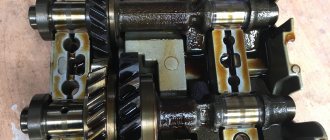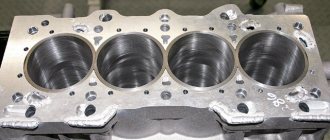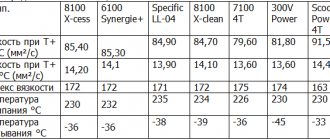Tips and tricks
By the way, in order to approximately determine how much volume will need to be pumped out, you need to remember how much oil is usually poured into the engine so that the level is normal. For example, if 3.7 liters need to be poured into the engine, then a level above the maximum on the dipstick will indicate an overflow of about 250-300 ml, that is, about 4 liters of lubricant were poured into the engine. This means that in the case of a 20 cc syringe, you need to make about 12 approaches to pump out such excess.
Please note again that if there is no fresh oil to top up, then only clean containers should be prepared to drain the pumped out oil. If by chance it turns out that more lubricant was pumped out of the engine than necessary, then such oil can be safely added from a bottle or can back into the engine. The main thing is that it is clean, free of impurities and contaminants.
The final step will be to properly check the engine oil level. If the level is in the middle or slightly higher, the unit can be started. Next, you need to warm up the engine, then be sure to place the car on a flat horizontal platform. After this, you should wait about 15 minutes and then check the lubricant level.
We also recommend reading the article about why the engine oil level rises. From this article you will learn about the main reasons for the increase in engine oil level, as well as what to do in this case.
If there is a need for topping up, certain rules should also be followed. Oil is added little by little, and not at once, after which you also need to wait until the lubricant drains into the pan. If in the end it turns out that the level is slightly above average, this can be considered normal.
Draining oil through the dipstick tube
Changing the oil through the dipstick (it should be clarified that this is how the oil is only removed, filling occurs through the filler neck) is done using a special installation. It has a fairly simple design and may look different depending on the manufacturer.
To describe it in general terms, the solution consists of a container for receiving used oil, a tube with a hose and a pump that creates a vacuum in the container. By the way, there are also more complex, professional devices designed for use in car repair shops. But the operating principle remains the same.
The pumping process occurs due to an artificially created pressure difference inside the engine and inside the installation itself. The procedure goes as follows:
- The installation tube is inserted into the dipstick tube. She sinks to the very bottom;
- a pressure difference is created;
- oil is pumped out;
The speed of oil pumping depends on the installation itself, as well as on the viscosity and temperature of the liquid itself. But, on average, this rate is about 1 liter per three minutes. Thus, if the engine is filled with 5 liters of oil, the process of removing it will take 15-20 minutes.
Currently reading:
Vehicle speed, engine speed and load...
Jan 1, 2020
How to disassemble and reassemble a car engine
Jan 1, 2020
For many motorists, pumping oil out of the engine through a tube may seem unusual and cause mistrust. However, car service employees who practice this procedure confirm its effectiveness and benefits.
The advantages of tube pumping are:
- The used oil is completely removed, while with a normal drain, up to 10-15% of the “waste” remains in the engine;
- This method makes it possible to change the oil in cases where it is not possible to change the oil as standard or is difficult for various reasons;
- Time saving;
In fairness, it is necessary to point out some disadvantages that may make car enthusiasts think about how best to drain the oil from the engine, standardly or using an installation.
We also recommend reading the article on how to flush the engine when changing the oil. From this article you will learn about various methods and methods for flushing the engine and its oil system before changing the lubricant, in case of switching from one type of oil to another, etc.
There are also disadvantages of this method:
- “Heavy” residues and clots of oil mixed with metal particles, dirt, burnt grease, etc. may remain in the pan;
- Quite a high cost of installation for self-replacement or the cost of the procedure in a car service;
- Simultaneously with the replacement, an inspection of the lower part of the car is not carried out; the presence of faults diagnosed by chips in the oil may not be detected in a timely manner.
How to drain excess oil from a car engine without lifting the car
Recently I had the need to go on a long trip by car. Moreover, this was very unexpected, and the brothers were needed several hours in advance.
And before a long trip, the car should be checked. Since I did maintenance just a couple of months ago, I only checked the tire pressure, spare tire, oil level and other technological fluids, and a set of tools in case of an emergency.
As a result of this check, it was discovered that during maintenance the oil had been significantly poured into the engine. Discovering this in the evening a few hours before departure is not very pleasant. You can, of course, drive with overfilled oil, but this is fraught with a decrease in the service life of the engine, namely the sealing elements in it.
Excessive oil leads to increased pressure inside the engine during operating conditions. Because of this pressure, seals fail faster and the engine loses not only oil, but also its performance characteristics.
Repairs can cost a pretty penny, and fixing the problem is a breeze, unless it’s the evening before departure.
I was offered to come to the service station tomorrow morning , which did not suit me, so I had to think about how to solve the problem myself.
My first thought was to go to an auto parts store and ask for some kind of device that would allow me to pump out the oil without lifting the car or driving it into a pit, because I didn’t have such an opportunity.
Several stores told me that such a special device seems to exist in nature, but it is not on sale because no one asks for it.
I started calling my friends to find at least some garage mechanic who could help with the problem.
And while doing this I was caught up in the idea of looking on the Internet to see how this could be solved using “folk methods.”
I found the solution on auto-infosite.ru (here). I really liked the idea of pumping out excess oil with a syringe, and I immediately went to the pharmacy.
He asked for the largest syringe and asked for some kind of tube to go with it. The saleswoman, of course, did not understand what I needed. I started asking what kind of tube it was. The guard heard this, came up and asked why I needed all this.
I say: “You won’t believe it, pump out the oil from a car engine.” He was dumbfounded for a second, but then said: “Why, I believe.” For him, apparently, this was something new in his boring work, so he animatedly began to offer his options for solving the problem.
As a result, the saleswoman offered me an IV system that had the necessary tubes.
In general, I bought a 20 ml syringe (I didn’t have any more) and a dropper system. All this cost less than a hundred rubles, 60-70 rubles, in my opinion (I forgot how much exactly).
After that I went to my garage to try to do something with this set.
Upon arrival, I let the engine cool down to 70 degrees so as not to burn my hands when pumping it out, and so that the oil would be as thin as possible. To do this, I opened the hood and left it there. I spent this time going to the store. I needed to buy groceries for the trip. About 30 minutes later I returned to the garage and began the task.
To be honest, I didn’t believe that I would succeed, but I didn’t really have anything to lose.
I attached the tube to the syringe, took out the oil dipstick, measured its length and cut off a tube 10 centimeters longer than this dipstick (if you don’t cut it off, the tube turns out to be very long).
Then all that was left was to push the tube into the hole into which the oil dipstick is inserted and try to pump out the oil.
You can’t even imagine my joy when I succeeded!
BeerBoy174 › Blog › How to drain excess oil
Is excess oil in the engine GOOD or BAD?
How to drain excess OIL (several ways) (useful tips) How does it happen that excess oil forms in the engine? YES, everything is simple, we added extra oil to the engine, poured a little and everything on the oil dipstick is no longer in the middle, the mark is at the maximum or “above” level. But excess oil in the engine is not at all good...
• What are the consequences of excess oil in the engine?
But the consequences can be the most dire. A lack of oil, like too much oil in the engine, is not good for the engine. Lack of oil is understandable, oil starvation, increased engine wear and subsequent breakdown.
• But what can excess oil do in the engine?
Excess oil is also not good. If you overfilled just a little, then the level on the oil dipstick will be slightly above average, but below the maximum level this is not a problem. But what to do when the oil level on the dipstick is above the maximum mark? And why is there a “maximum mark” for the oil level on the dipstick?
Excessive oil levels place more stress on the engine seals, and the “excess” oil can contribute to leakage of these seals. Excess oil in the engine is especially bad in winter. The oil thickens, and therefore the pressure on the seals increases significantly.
• How to remove excess oil from the engine?
1 METHOD. In general, excess oil in the engine needs to be drained. You can do this in three ways.
The first and easiest way. This means going to a specialized station where they change the engine oil and there they will pump out the excess oil for you. Easily? YES! But there is one BUT! It costs 500 rubles to remove excess oil. We need to find such a station, and they may not be able to contact such a small thing.
METHOD 2 is more difficult. You need to unscrew the oil plug on the engine crankcase and drain excess oil through it.
But there are also several disadvantages: you need to crawl under the car, remove the engine protection, you need to unscrew the oil plug, but this is not always easy, you also need to drain some oil, but oil flows through the plug very quickly! So this method is also not very suitable.
METHOD 3 – optimal. Drain excess oil through the dipstick tube. I will give detailed instructions.
1) So, in order to remove excess oil from the engine, you first need to buy a medical system - a dropper and a syringe, with a large volume, the more the better (at the pharmacy where I bought the maximum volume was 20 Ml).
We have an IV and a syringe on our hands.
2) Cut off all excess from the dropper, leaving only the tube.
3) We put the dropper on the syringe. It turns out to be a syringe with a long tube from a dropper.
4) Now let's go open the hood. We take out the oil dipstick, insert the tube and fill the syringe.
5) Then you need to pour the oil that has accumulated into a container
6) Lower the tube again - fill the syringe - drain. You need to repeat the required number of times.
I repeated this 13 times, that is, I drained about 260 Ml.
After that I measured the oil level, now the level is at the proper level. Slightly above average. This is completely acceptable.
Why change the oil in your car engine?
A car engine is a complex structure, the operating principle of which is based on the rotation of various parts. This creates friction, which oil is designed to minimize. It also removes heat from engine parts and protects them from corrosion. Timely replacement is necessary to extend the life of the motor.
It is recommended to change the oil fluid every 10 thousand kilometers , unless a different period is specified by the manufacturer.
Changing the oil on time reduces engine wear, namely:
- reduces friction of engine parts;
- reduces the formation of corrosion.
prevents engine overheating;
Methods for changing engine oil
Traditionally, the oil liquid is drained through a hole, but there is also an express method of pumping out the waste using a pump. The second method is much simpler due to the absence of the need to lift the car and remove the protection from the engine.
Replacement by draining through a hole
With this method, the waste is drained through a hole located in the engine sump. It is closed with a plug, which requires a special key to unscrew.
During this procedure, it is also necessary to replace the drain plug gasket.
Replacement by pumping out using a pump
This method involves pumping out the waste fluid without unscrewing the oil plug. The oil pump can be manual, mechanical, or electric based on a small motor. You can buy it in a store or make it yourself.
Why does oil overflow occur?
You have conscientiously drained the waste, replaced the filter, tightened the drain plug and filled in fresh lubricant according to the regulatory instructions. Then you take out the dipstick and observe in horror the level a few millimeters above the maximum. Where did the excess oil come from?
It will be useful: What is the best interior antenna for a car radio?
You have filled the amount calculated for an empty (more precisely, dry) engine crankcase. However, they did not take into account the fact that in the cavities, on the horizontal surfaces of the crankcase, and finally, in the hydraulic compensators and dampers, there is a little old lubricant. This “little” can reach 200-400 ml.
Changing oil using a pump: advantages and disadvantages
This method of replacing used fluid has both advantages and disadvantages.
The advantages include the following:
- no special key is needed for the drain plug;
- no need to lift the car on a lift;
- the process of pumping out oil takes much less time than draining it.
Disadvantages of the pumping method:
- low wear resistance of the tube with insufficient skill there is a possibility of accidentally breaking it;
- there is a risk of not completely pumping out the waste, and sediment may remain.
Micropump for changing oil with clean hands: putting it to the test
Changing the oil is one of the most basic procedures in car maintenance yourself, but it is far from the most pleasant. You can make it simple and comfortable with the help of a simple gadget for nominal money. Let's check how an interesting technical solution works, allowing everyone to change the oil in ten minutes without a garage, without a pit, and without even changing into work clothes!
Needless to say...
On the website of a popular Chinese online store, in the description of a 12-volt water pump for arranging fountains in aquariums and country decorative mini-pools, we accidentally came across an interesting review from a Russian car owner who used this pump as a system for pumping oil out of the crankcase of his Fiat engine. Bravo!
The pump is designed for water, but the cunning citizen quickly realized that if you connect thin hoses and wires with a pair of alligator clips to it to power the device from a car battery, you will get an ultra-low-cost system for changing the oil in an engine or gearbox! Similar pumps complete with tubes and wires, designated as specialized for pumping out oil, cost from 2,000 rubles or more in a Chinese online store, so in this case it turns out to be an extremely economical option.
This solution, of course, is not relevant for everyone - after all, what is the use of pumping out oil through the dipstick if you still need to crawl under the “belly” of the car in order to unscrew the filter? However, there are quite a lot of cars in which the modification of the engine and the layout of the engine compartment make it possible to easily unscrew the oil filter from above from under the hood: from the Granta to the Focus and from the “Volgov” old man ZMZ-402 to the “Skoda” 1.2 MPI with replaceable paper elements in glasses. Well, there are some unique ones - Volkswagen engines CAXA, CFNA, etc., in which the filter is located almost vertically at the level of the block head, as a result of which unscrewing it is even easier than adding water to the washer reservoir. Plus, the filter is removed completely clean and empty, without a drop of oil.
Let's check how convenient and feasible the proposed solution is? Our goal is to determine the efficiency of the pump, whether the performance is sufficient when working with thick oil instead of water, and most importantly, how durable is its design? After all, if in the interval between oil changes the waste residues in the pump destroy its plastic from the inside, then there is no point in such “handjob”...
Pump design
The design of the pump surprised and upset me. There was a feeling that the cunning citizen who threw the idea into the masses did not disassemble it before using it as an “oil pump”... The principle of operation of the Chinese craft is almost the same as that of high-pressure pumps of washing installations “a la Karcher”, but not on based on metal plungers-pistons, and on the basis of silicone elastic membranes. An eccentric is installed on the electric motor shaft, which, rotating, alternately lifts the pumping membranes arranged in a circle. One-way flow of liquid is ensured by check valves made of the same transparent silicone.
This design of the pump pump unit raised doubts. Of course, it sucks water without problems, but oil can quickly corrode or soften and deform rubber membranes and valves, rendering the gadget unusable. Therefore, after clarifying the design features of the pump, what came to the forefront of the experiment was not checking the ability to pump engine oil, which, in general, is obvious, but the ability of the device to remain operational after that!
Let's pump the oil!
To pump oil through the dipstick hole, you will have to select a suitable plastic tube. This task is not to say difficult, but, to some extent, creative. The tube must fit into a narrow hole and have thin enough walls so as not to resist the flow of oil. In our case, we came across a Russian-made television antenna cable, from the shell of which we pulled out the central core and inner braid, holding the tail in a vice.
A real experiment confirmed the efficiency of the pump - approximately three and a half liters of oil from the WV Polo engine are vigorously pumped out in about five to six minutes; The motor heats up during this time, but not critically. A test unscrewing of the oil pan plug showed that no more than half a glass of oil was not sucked out. In general, a non-critical amount, which can also be reduced by splashing 200 grams of pure fresh oil into the oil filler neck after bubbles come out of the pump.
Is the pump durable?
Leaving the pump in an uncleaned state after changing the oil is fraught with danger. Lubricant can corrode or dissolve the rubber filling of the pumping unit while you roll back 10,000 km, waiting for the next replacement... Therefore, we carried out a control measurement of the pump’s performance on water (which showed that the pump pumps three liters of water in about two minutes), after which washed it thoroughly and measured its performance again after a month to make sure it had not deteriorated and its efficiency had not decreased.
Cleaning the pump from oil from the description may seem like a chore, but in fact it is very simple and took no more than five minutes in total - you won’t even get your hands dirty. First, we lowered the suction and outlet hoses of the pump into a jar with about one hundred grams of gasoline and ran it in a circle. The pump spun the gasoline for a couple of minutes, washing out the remaining oil. After which it was lowered into a similar container, in which a couple of tablespoons of detergent were added to two hundred grams of water. And the pump also drove this liquid in a circle for a minute or two - at this point the cleaning was completed. Perhaps it would be more correct to disassemble the pump, but removing the membranes (and then inserting them back!) is quite difficult, and in this case the whole idea becomes meaningless...
A control measurement showed that the pump was not damaged - its performance did not decrease, which means that we cleaned it well. The system works and has a right to exist, verified!
Types of oil pumps
Currently, you can find a huge number of types of pumps on sale that allow you to pump oil out of a car engine. We list their main types:
- Manual mechanical or vacuum pump.
- Pneumatic pump.
- Electric pump of various designs. Can operate on 220V or 12V voltage.
Among the manual ones, barrel pumps are popular: siphon, rotary and lever pumps for diesel fuel and kerosene. They are used to pump oil from a barrel.
Electric pumps are divided into the following modifications:
- gate plate;
- plunger;
- diaphragmatic.
These models are also suitable for pumping diesel fuel or waste oil liquid.
We make a pump for changing the oil with our own hands
It is also possible to make an oil pump with your own hands. In this case, it is possible to get by with a simple design based on a medical syringe, or make a more complex design using an electric motor.
Medical syringe pump
This device is a mechanical hand pump for oil. A syringe pump is ideal for extracting small volumes of liquids. Use this design to pump oil out of a car engine.
Materials and tools
To make a pump for changing oil through a dipstick, you will need the following materials:
- medical syringe 20 ml or more. You can try to get by with a smaller volume, but the process of pumping liquid will be quite long.
- an IV from a pharmacy, only a tube will be useful for it. If desired, use a similar tube or hose that matches the diameter of the syringe.
- An empty bottle or other container to collect used oil.
Sequence of work
- Cut off all excess from the dropper with scissors so that only the rubber tube remains.
- Place the tube onto the cone of the syringe.
- After opening the hood, remove the oil dipstick from the car engine.
- Slowly pull back the piston until it is completely filled with waste.
- Now you need to disconnect the syringe and drain the used oil into a container. You can completely remove the tube from the engine and place it in a container to drain the liquid.
- Repeat the procedure as many times as necessary.
Why is overflow dangerous?
Many drivers believe that excess oil level is a temporary phenomenon. In their opinion, after a short time, the excess lubricant will burn out, and the level will return to normal. But the danger is that during the period of natural “burnout” the oil will harm many engine components. Regular overflow leads to the following phenomena:
- an increase in pressure on the oil seal and other seals and the occurrence of leakage;
- clogging of the muffler and the need to replace it;
- premature formation of excessive carbon deposits on the pistons and inside the combustion chamber;
- Exceeding the load on the oil pump and reducing its service life;
- malfunction of the ignition due to clogging of spark plugs;
- rapid wear of the oil filter;
- increased fuel consumption due to reduced torque.
All these consequences are expected and will not cause sudden “death” of the motor. However, the risk of parts failure increases significantly and threatens serious material costs: the engine works worse and worse, the engine compartment becomes dirty and gradually corrodes.
Causes of overflow
Exceeding the oil level is generally allowed when replacing or topping it up. In the first case, haste gets in the way. Incomplete drainage of used oil by gravity leads to retention of residues in the system. When a new portion is filled in according to the norm, the old oil mixes with the new one and the level is exceeded.
The topping operation is often used by owners of cars with an oil-consuming engine. They carry out the procedure “by eye”, so overflow is inevitable. Another reason is mixing oil with unburned fuel. This happens when there are unsuccessful attempts to start the engine, most often in cold weather.
Draining oil from the engine: photos and videos
Many car enthusiasts have wondered how to drain oil from the engine. This is done for different reasons and with different intentions. Of course, it is worth understanding that not all motorists are capable of not only draining the oil, but even finding the oil level (dipstick) on the power unit. So, the article will tell you how to drain the lubricating fluid from an internal combustion engine and for what purpose this is done.
How not to overfill engine oil when replacing it again
Why do we get an oil level higher than the maximum on the dipstick? There are several reasons for this:
- Inattention. If you missed the moment when it was necessary to remove the canister from the oil filler neck, you end up with a surplus.
- Inexperience. Any car engine has a residue that cannot be drained. Even after warming up, its volume reaches 0.5 liters. If you don’t take this into account and pour in according to the instructions, you will end up with a lot of lubricant.
- Intentionality. When the engine eats oil, this does not mean that you need to pour in reserve. Firstly, this is money down the drain - lubricant consumption will only increase, and secondly, the power plant acquires a whole bunch of consequences associated with an increased level of lubricant composition.
To avoid overfilling the engine with oil, follow a number of simple rules:
- Be careful.
- Separate the so-called main volume, which can be safely poured (for small cars this is 2 or 3 liters).
- Carefully bring the level halfway between the MIN and MAX marks, dispensing small amounts of fluid and checking the dipstick.
- Start the engine and wait until the oil pressure light goes out.
- Stop the power plant and add oil to the specified level.
Reasons for draining oil from the engine
All motorists know and have also encountered the fact that they changed the oil in the main power unit. There are many reasons for carrying out this process, but the main one is the manufacturer’s recommendation. But the question often torments us: why drain the oil from the power unit so often? We will try to answer this question below:
- Oil fluid, like any element of a car, has its own expiration date. Thus, the use of this liquid on a vehicle leads to its loss of its qualities after a certain period of time or mileage.
- The oil loses its technical qualities, namely changes in the chemical composition, as well as the presence of physical third-party elements (metal shavings).
- Change oil according to scheduled maintenance.
- Many car enthusiasts pour fluid into the power unit, and then are tormented by the question of how to pump the oil out of the engine.
- Major repairs, during which the oil must be drained.
- Replacement of structural elements of the car (which are not included in the overhaul), such as liners, yokes or timing elements (oil seals, gaskets).
- When oil of the wrong marking was mistakenly poured into the engine or two different fluids were mixed.
- Other reasons not listed.
So, as you can see, there are many reasons why it is necessary to drain the fluid from a car engine.
Disadvantages of the method
The disadvantages of this method include:
- The biggest disadvantage of an express oil change is the inability to completely remove the so-called “ heavy oils ” - oil mixed with metal dust, dirt, and burnt oil residues that accumulate in the lower part of the engine sump.
- It is important to monitor the amount of oil pumped out, and also be extremely careful not to leave foreign objects in the engine.
- It is impossible to perform this procedure yourself, without special equipment, which costs on average 10,000-15,000 rubles .
- With a vacuum oil change, unlike the traditional method, there is no opportunity to inspect the chassis and underbody of the car.
How to pump oil out of an engine
There are two ways to pump out motor lubricant from the main power unit. Both methods are good, but car services, as practice shows, use only one, since it is proven and does not cause any problems. So, let's look at the detailed instructions on how to drain the lubricant from the engine.
Option 1 - traditional
Drain the oil from the filler plug, which is located on the engine oil pan. This method is used when changing the oil or, if necessary, draining excess oil from the engine. The technological process is quite simple:
- As with any repair, it is first recommended to disconnect the negative terminal from the battery. Of course, car enthusiasts don’t do this, relying on luck.
- We install the car so that there is access from below, that is, a pit or a lift will do.
- We substitute containers from 5 to 14 liters, depending on the classification and capacity of the cylinder block.
- We unscrew the drain plug and wait until the oil flows out of the engine.
Option 2 - play with straws
The second option, of course, is not the most convenient or the best, but it is rarely used. So, the motorist must insert a tube through the filler neck and connect a small pump or use a suction the old fashioned way to pump out excess oil from the engine.
Important! You should not resort to this method, since the entry of motor lubricant into the human body can lead to the fact that he ends up in the hospital with poisoning.
This method is quite common when oil is poured into the engine. Pouring lubricant and then pumping it out is not particularly convenient, and can also become unpleasant. Therefore, when pouring liquid, it is better to underfill a little rather than overfill.
How to remove excess oil through the drain hole
At its core, this method is a regular oil change. But with one difference: the oil that is drained is not used. That is, the principle is this: the oil material is completely drained into a certain container, and then it is poured back, only in the correct quantity.
This option for removing excess is best done in a hole or on an overpass. Be sure to give the car time to cool completely. Because the oil is very hot (working temperature 90°) and can cause severe burns. Before the procedure, stock up on a container where the transmission fluid will be drained and a spanner wrench to unscrew the plug.
- When the vehicle has cooled down, you can proceed directly to removing the oil. To do this you need:
- Open the hood of the car and unscrew the filler cap.
- On the bottom surface of the motor, find where the drain plug is located.
- Before unscrewing the drain plug, place a container for oil liquid.
- Using a spanner wrench (can be replaced with a wrench), slowly and little by little unscrew the plug. In the end, you can usually tighten it with your hands, but be careful not to get yourself covered in oil.
Now you need to leave the car for about 30 minutes so that the transmission fluid drains out.
When the engine oil is full, the drain plug needs to be tightened. This must be done quite tightly, but without unnecessary zeal. If possible, it is better to use a torque wrench. In this case, the maximum tightening force should be no more than 25nm.
Now all that remains is to pour the lubricant back in. But carefully monitor the level so that there is no overflow again.
Consequences of mixing different types of oils
As you know, there are cases when draining the oil from the engine is necessary even before the power unit has started after maintenance. This could be an accident or simple negligence. This situation is called mixing different types of lubricating fluid. So, why do you need to drain the oil from the engine? - the answer to the question is quite simple:
- When two different types of liquid are mixed and both have different chemical compositions. Accordingly, they begin to lose their useful and necessary qualities. In the case of oil, this is cooling and thermal conductivity. Therefore, the motor may overheat and this will lead to more significant consequences.
- Draining the oil is necessary as a forced procedure, since the different physical properties of two different fluids can lead to increased wear, as well as the formation of an increased amount of metal shavings, which will only accelerate the wear process of the main elements of the power unit.
- Mixing different types of lubricant leads to the fact that the oils lose their lubricating properties, and accordingly all gaskets and seals are automatically subject to decomposition and rapid wear, which can result in a leak that can only be eliminated through a major overhaul.
Of course, there are other reasons and consequences of mixing different types of lubricating fluids, which will require draining the oil from the main power unit.
What happens if you pour motor oil into the engine above the upper level?
How bad things get depends on the volume of overflow. Agree, the difference between 200 grams and 1 liter is significant.
A little extra lubricant in the engine: are the consequences noticeable?
A little is everything that is above the MAX mark within 1 cm. Say, the same extra 5 mm will not bring much harm. Subjectively, of course, one can complain about the deterioration of dynamics, but the underlying reason for such a complaint is one - self-hypnosis, nothing more.
What will really be noticeable is an increased appetite for butter. The extra centimeter will go away within the first 1,000 km. The negative is that excess lubricant will settle in the form of coke on the oil scraper rings, carbon deposits on the walls of the combustion chamber and soot in the catalyst.
If you regularly fill in a lot of oil, then after a while you will become interested in how to flush the engine from carbon deposits inside, and how to do it without disassembling. Soon questions about the exhaust will arise: how to replace a clogged catalytic converter and how to make a lambda probe blende.
What threatens an impressive overflow
Anything above + 1 cm is considered a critical excess of the norm, and here’s why:
- If there is a significant excess of liquid, the crankshaft will dip its counterweights into it, which will result in foaming, which is very bad. For an oil pump, this is cavitation with its erosive effect on parts; for a semi-automatic gas distribution mechanism, this is what causes hydraulic compensators to knock when cold and hot; and for the oil itself, it is the incomprehensible behavior of additives.
- The excess will definitely be thrown out to the intake through crankcase gas recirculation, which is also not good. The inside of the intake pipe will be enveloped in oil droplets, the throttle assembly will become dirty, and the stem and plate of each valve will be covered with malignant deposits.
- The seals will leak. They are not designed to bathe in oil. Their function is to repel splashes.
For your information. It doesn't squeeze out the rubber from overflowing. This happens due to an increase in crankcase gas pressure. And this leads to completely different problems: a clogged ventilation tube or problems with the oil separator.
Conclusion
In many cases of vehicle operation, it may be necessary to drain the oil from the internal combustion engine. Of course, not a single manufacturer recommends carrying out this process yourself, but only at a car service center. Still, car enthusiasts do everything themselves, with their own hands, to avoid additional waste, since the pricing policy of most car services leaves much to be desired.
At the same time, we should not forget that incorrectly replacing the lubricant will entail a lot of troubles, so it is better to pay extra for a replacement than to “end up” with a major overhaul of the “heart” of the machine.









